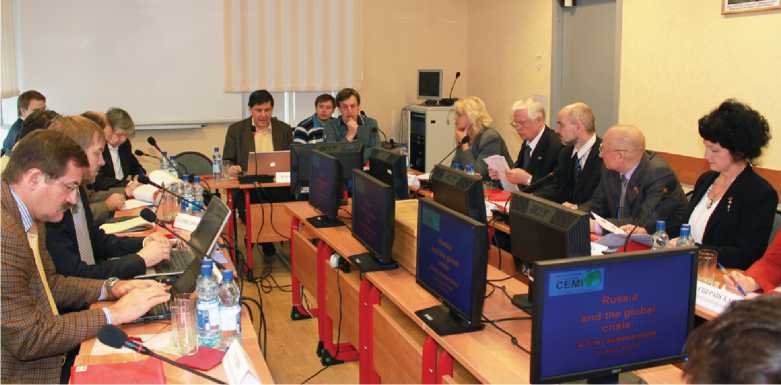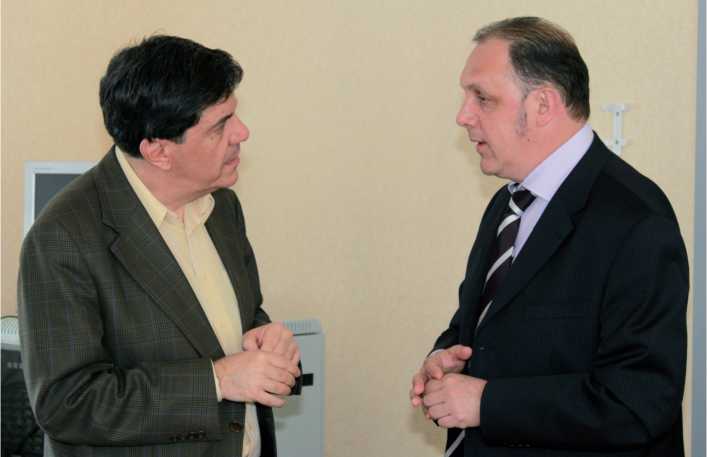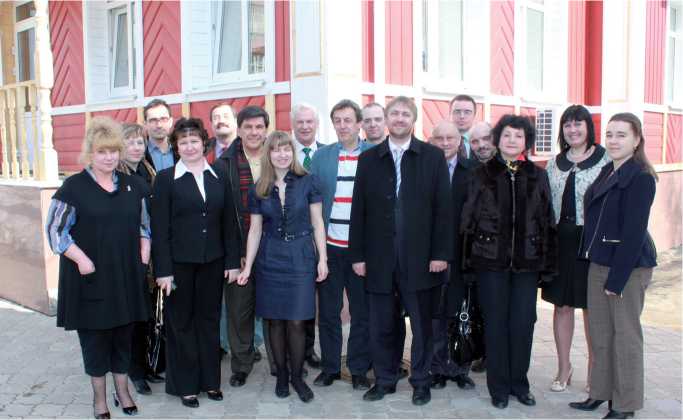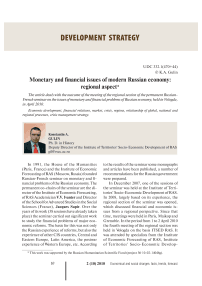Monetary and financial issues of modern Russian economy: regional aspect
Автор: Gulin Konstantin Anatolevich
Журнал: Economic and Social Changes: Facts, Trends, Forecast @volnc-esc-en
Рубрика: Development strategy
Статья в выпуске: 2 (10) т.3, 2010 года.
Бесплатный доступ
The article deals with the outcome of the meeting of the regional section of the permanent Russian-French seminar on the issues of monetary and financial problems of Russian economy, held in Vologda, in April 2010.
Economic development, financial relations, market, crisis, regions, relationship of global, national and regional processes, crisis management strategy
Короткий адрес: https://sciup.org/147223180
IDR: 147223180 | УДК: 332.1(470+44)
Текст научной статьи Monetary and financial issues of modern Russian economy: regional aspect
In 1991, the House of the Humanities (Paris, France) and the Institute of Economic Forecasting of RAS (Moscow, Russia) founded Russian-French seminar on monetary and financial problems of the Russian economy. The permanent co-chairs of the seminar are the director of the Institute of Economic Forecasting, of RAS Academician V.V. Ivanter and Director of the School for Advanced Studies in the Social Sciences (France), Jacques Sapir. Over the years of its work (38 sessions have already taken place) the seminar carried out significant work to study the financial problems of major economic reforms. The basis for this was not only the Russian experience of reforms, but also the experience of other CIS countries, Central and Eastern Europe, Latin America, the postwar experience of Western Europe, etc. According to the results of the seminar some monographs and articles have been published, a number of recommendations for the Russian government were prepared.
In December 2007, one of the sessions of the seminar was held at the Institute of Territories’ Socio-Economic Development of RAS. In 2008, largely based on its experience, the regional section of the seminar was opened, which discussed financial and economic issues from a regional perspective. Since that time, meetings were held in Paris, Maikop and Grenoble. In the period from 1 to 2 April 2010 the fourth meeting of the regional section was held in Vologda on the basis ITSED RAS. It was attended by specialists from the Institute of Economic Forecasting of RAS, Institute of Territories’ Socio-Economic Develop-

At the seminar meeting
ment of RAS, Southern Federal University (Rostov-on-Don), Astrakhan State University, CEMI-EHESS (Paris), University of Lion-III Jean Moulin, the Government of the Vologda region. The main topic of the discussion was the impact of economic crisis on the development of Russian regions, the impact of global crisis processes on the state and prospects of national and regional economies.
The session of the seminar was opened by the research director of the School for Advanced Studies in the Social Sciences (CEMI-EHESS) J. Sapir . In characterizing the crisis in Russia, one of the most respected foreign experts on Russia's economy estimated it as very deep, but limited in time (from December 2008 to April 2009). The most significant manifestation of the crisis was a significant fall in production (especially in manufacturing) and the reduction of household income. The causes of the crisis were a significant reduction in the price of oil and aluminum, the reduction in external demand, the fall of the internal credit (which led to declining domestic demand), the specificity of the monetary policy pursued by the Central Bank.
According to Jacques Sapir, the Russian economy is growing stronger in the domestic market and less dependent on external demand. Consequently the domestic market during the crisis potentially should be a factor of crisis resistance. However, the Russian economy is supported by more exports and imports rather than its domestic market, which is a consequence of the policy of the Central Bank of Russia. Until the beginning of the most active phase of the crisis, it carried out a gradual increase in the rate of refinancing, while major central banks lowered their rates (in November 2008, the CBR refinancing rate was 12%, while the U.S. central bank rate was 0,5%, Japan -0,1%, European - from 0,5 to 0,75%). Effects of refinancing rates increases immediately reflected on the sale of real estate and loans for consumption. By reducing the inflation rates consumer loans and lending rates for businesses were growing.
The reasons for this policy of the Central Bank are the transition to a policy of inflation targeting, protection of the ruble exchange rate, the effects of previous policy of the Central Bank. The Central Bank of Russia chose the inflation targeting policy too late (only in late 2007, while central banks of Western European countries included such a policy in 1990), and at the most inopportune moment. The problem of inflation targeting means that the central bank should focus on it at the expense of all other tasks. And in that situation, in which Russia was in early 2008, the Central Bank had to act as a lender of last resort, contrary to the policy of the new consensus.

J. Sapir, L.G. Iogman
Did the crisis cast doubt on the modern model of Russia’s development? Until the crisis the investment policy had a relative success the country (in the period from 2003 to 2008, the volume of investments rose from 16,5 to 21% of GDP), which resulted in a dramatic increase in labor productivity (in manufacturing by 48%, in extractive industry by 31%). But this policy needs sustainable funding and more adapted actions of the Central Bank. To get out of the crisis for good and all, this problem must be urgently addressed.
Unlike Jacques Sapir, who has taken growth rates as a criterion for ending the crisis, the head monetary research laboratories of the Institute of Economic Forecasting RAS PhD in Economics O.G. Govtvan expressed the opinion that Russia is still far from ending the crisis. To say yes to this, on the one hand, there must be stable factors and growth mechanisms, on the other the behavior of economic agents must change: risk-oriented behavior must be replaced by behavior oriented on economic efficiency.
Talking about ways out of the crisis it is not enough to rely only on "technical" analysis; we must proceed from the fundamental nature of the crisis. The speaker therefore described the revolutionary changes in the financial sector during the last 100 - 150 years. Totally one can talk about three revolutions. First is the transition to a two-tier banking system, which fastened to the reference to debt in contrast to the previous reference to the gold. Second is the emergence of financial market, i.e. the evaluation system of private debts, resulting in approaching of real funding to funding needs. And third is the revolution of the last 10-15 years - the emergence of market risks (market risk management tools).
The risks market (allowing a tremendous increase in the accuracy of debt estimation) began to play a significant role in financial processes. The result of this third revolution is a significant increase in funding. The problem is the lack of regulation of this market. While each country controls the cross-border outflows of capital liquidity, no one can control the crossborder outflows of risks. To get out of the crisis on the global level one must take a significant structural decision that would eliminate selfreplicating processes on the risks market and to build regulatory instruments.
Today, Russia is characterized by multi-level nature of the economy: it is represented by the subjects of global, national and regional level. However, the anti-crisis policy mainly focuses on the enterprises of global level. At the same time at the regional level self-motivation cannot be detected due to the fact that the economy "runs" from the risks. The possibilities here are seen in the development of a specialized bank credit and refinancing institutions.

Photo for memory
According to S. Durand (Centre for industrialization study of the School for Advanced Studies in the Social Sciences), the crisis clearly showed the specifics of Russian capitalism. Its main and most striking distinguishing feature is the dependence on commodity exports, imports of consumer goods and equipment from the international financial turnover. This leads to a high degree of vulnerability of the Russian economy in relation to external shocks.
The second feature of Russian capitalism is the specifics of economic coordination dominated by political and economic bargaining relationship, the weakness of private property rights, ownership concentration, the preservation of the industrial sector inherited from the Soviet period, the high proportion of energy in the economy. These are the elements which illustrate the increasing interdependence between political and economic factors at all levels (national, regional, local). These political and economic networks are involved in the distribution of rents and regulate mechanisms of external shocks absorption.
According to S. Durand, the crisis showed the weakness of Russian capitalism, but it strengthened the role of the state as an economic player. On the one hand, enterprises asked the state for support (including the largest ones). On the other hand, due to the state’s actions social shock has been depreciated (in contrast to the 1998 crisis). In crisis of 2008 - 2009 the social shock was less than the economic one (as evidenced by the increase in the wage share in GDP). And at the same time, we cannot say that the capital paid for crisis itself (reduction of the capital share in GDP, but very small). Restoration was carried out by the state budget that is the state was paying for the crisis due to previously accumulated reserves.
A significant block of presentations was devoted to certain region’s experience in crisis situations and on their future development.
Considerable attention was attracted by the report of the Head of Economic Department of the Government of the Vologda region, the first deputy governor, PhD in Economics L.G. Iog-man. It was devoted to the influence of financial and economic crisis on the region's economy and its development prospects.
The Vologda region is a region largely embedded in the global economy; it was growing successfully and steadily until October 2008. In the following period, due to a sharp fall in export prices and the corresponding "compression" of demand, a sharp decline in the leading sectors of the economy came - particularly in metallurgical and chemical industry (in October - November 2008, the volume of production there declined by about half). The regional budget declined by a half. The region was among the Russian territories most affected by the crisis.
Building an anti-crisis plan in these conditions, the regional government took into account both Russian and world trends. The guideline to preserve social stability was taken. This required the full range of social obligations, timely measures to promote employment.
A wide range of mechanisms of state support for enterprises was included: trade interventions, ensuring the formation of state order, forward purchasing of goods and services, providing direct financial assistance, provision of regional government guarantees for loans, assistance to sales of products, optimization of tax burden, support of businesses being in a critical situation, subsidizing the transfer of community facilities in the municipal use, active support of small business. With these measures, the active work of the enterprises themselves, as well as changes in the market the economic situation in the region has stabilized by the end of 2009. According to forecasts, in 2010, it is expected an increase of industrial production at 102,5% of the previous year, although it is rather difficult to return to the positions of 2008.
The realization of investment projects and infrastructure development remains to be the most important task despite the difficult financial situation. In this regard, the region managed to retain investment activity of enterprises continued to build and repair roads, energy and municipal facilities, social infrastructure, introduction of advanced telecommunications technologies. A particular area of the regional government’s focus is the creation of industrial parks and economic clusters (now there are two major projects of this kind in various stages of implementation – industrial parks “Sheksna” and “Sokol”). Activity aimed at improving the regional economy’s energy efficiency is also urgent: the rationalization of energy consumption and reduce of unit costs for these purposes, the use of energy-saving technologies, reduction of FEC product losses.
According to L.G. Iogman, the crisis cannot be measured only in negative categories. A positive aspect is that the crisis contributes to the so-called «natural selection», which leaves on the market only the most viable companies with strong policy management. This leads to general improvement of economy, sustainability and «flexibility» of national and regional economic systems.
“Academic” view of the problems of the region’s development was presented in a collective report made by scientists of the Institute Territories’ of Socio-Economic Development of RAS. The Institute, which celebrates the twentieth anniversary this year, conducts research on a wide range of directions, provides infrastructural support to the innovation activities in the region, it is actively engaged in the training of scientific personnel. V.A. Ilyin , Professor, Doctor of Economics, director of ITSED RAS told in detail about the tasks and prospects of the development. Heads of departments of the Institute focused on such issues of regional development as monostructural nature of economy, low labour productivity, imbalances in intergovernmental fiscal relations, weak financial capacity of local economies ( T.V. Uskova, Ph. D. in Economics, Deputy Director, Department Head), low potential for health and growth of social and economic stratification of the population ( A.A. Shabunova, Ph. D. in Economics, Department Head); reduction of intellectual capacity and quality of labor resources ( K.A. Gulin, Ph. D. in History, Deputy Director, Head of laboratory). These problems are not peculiar to the Vologda oblast and require significant changes in the policies of the federal center. The strategic work on the formation of new elites (including managerial) is extremely important to the regions along with solving economic problems. One of the possibilities here is the development of modern scientific and educational centers. Experience in establishment and development of such a center was shown by Deputy Director, Department Head, Ph. D. in Philology M.M. Karaganova .
The report of V.Y. Solopov, Professor, Doctor of Economics, the director of Institute of Economics and Law at Astrakhan State Uni- versity was devoted to the influence of the crisis on the economy of the Astrakhan oblast and long-term development of the region.
In the long-term development strategy of the region, developed before the onset of the crisis, hydrocarbon production, fishing and hunting tourism, agriculture and shipbuilding were considered as the main growth areas of the regional economy. All these areas remain actual in the crisis. Some sectors of strategic importance for the region (e.g. agriculture and house building), were able to pass through the crisis without losses.
The most significant problems in the region’s economy are: a low level of integration processes, the orientation of the major companies in the region to meet the tasks of national and global level; rent seeking of enterprises; new features of work motivation of employees (at a certain stage the decrease in labor productivity with the increase in wages).
The main directions of future development of the region are traditional agriculture, supplemented by the recycling process, recycling of existing and incoming resources, the use of a dominant position in the Caspian Sea in the area of personnel skills, forming of servicing and supporting industries, the production of expensive equipment for the developed industries.
The report of the Director of the North Caucasian research Institute of economic and social problems of the Southern Federal University, Doctor of Economics, Professor V.I. Ovchinnikov was dedicated to the problems and resources of the post-crisis stabilization on the macro-regional level, e.g. the regions in the North Caucasus federal district created in 2010.
The main problem is the territorial reticence of the economic space with a high degree of its disintegration generated by the autarkic tendencies. The share of the so-called «еtnoeconomic» household structure (55-60%) is high, which is characterized by such features as the dominance of informal institutions and the traditional social and economic structures, extensive type of employment and low level of population mobility, the organic link between production and employment with the household way of life, etc.
Mechanisms for implementation of the regional social and economic policies of the federal center in the North Caucasus are seen as following: to strengthen the effectiveness of the market-regulated model of economic organization, reorientation of the vector of regional policy from the sphere of distribution and redistribution of national income into its production, change of priorities in the ratio of financial redistribution and incentive functions within the policy of leveling regions development, the use of administrative resources; improvement of the Russian system of fiscal federalism; strict compliance with the categorical imperative «finance follows objectives».
Possible tools to stabilize social and economic situation in the North Caucasus are: implementation of the cluster model of interregional inter-industrial production and economic systems; target state support of processes of neo-industrialization and reconstruction of associated forms of commercial agricultural production, as well as infrastructural arrangement of all the clusters and economic and personal safeguarding, forming of special economic zones with effectively motivating financial regime, providing an intensive inflow of capital and «squeezing» of the terrorist underground.
The report of the head of the subdepartment of Economics Department of the Southern Federal University, Doctor of Economics, N.P. Ketova was dedicated to the potential of regional marketing tools for post-crisis economic stabilization. Regional marketing is an activity for exploration of the target markets within and beyond the region, stimulation of the production of competitive and called-for goods and services in the formation of channels and tools for increasing sales. We are talking about the competitive advantages created by (the efforts of government, business, population) the territory.
Examples of effective regional marketing are such countries as Thailand, UAE and Egypt established its own tourism industry. According to the speaker, today many Russian territories if there is political will and sense of leadership, understanding the need for coordinated efforts of various groups and sectors of society could, using the instruments of regional marketing, create conditions for overcoming the crisis and stabilization in the future.
For the Russian regions the experience of the development of the region Rona Alpes presented in the report of Professor of University Lyon III Jean Werkey is interesting. Rona Alpes is one of the leading regions in France with the population of 6 million people (about 10% of the country population). It is characterized by such features as the population growth (higher than in France and the EU as a whole), a high level of GDP per capita, the high density of economic space (the existence of a large number of small businesses).
The structure of the region's GDP is quite diversified. Industry and construction take a quarter of value added (in France as a whole -1/5 parts). Main sectors defining profile of the region are automotive, chemical, mechanical manufacturing and production equipment industries, energy. The result is a strong reaction to changes in economic conditions of the country. Another specific feature of the region is the «international» nature of the economy (45% of the French cargo transit pass through the region), which makes it more influenced by the crisis.
The policy of the regional administration is aimed at increasing economic resilience and focuses on two main directions. One of them is the support of «competitiveness poles» such as producing companies, which products are in demand on the global and European markets. There are 15 poles, among them are chemical industry, automotive industry, biotechnological industries, nanotechnological centers.
Another trend is a realization of the region’s own policies on foreign trade, one of the main tasks of which is the increase of the proportion of small and medium enterprises in regional exports. The mechanisms for such support are the provision of tax holidays for exporting companies; compensation for insurance risks in search of new markets; payment of a part of wages to companies’ management engaged in export sales; financing of arranged overseas missions in support of exports.
Companies having objectives can get 300 kinds of public assistance in the regions. The downside of such policies is the possible strengthening of the polarization between the leading territories and less affluent areas. And this is a problem requiring special attention at the national governmental level.
Scientific Secretary of the Institute of Economic Forecasting RAS, Ph. D. in Economics D.B. Kuvalin through the analysis of all-Russian polls highlighted the problem of post-crisis development of domestic enterprises in early 2010.
It was noted that the positive side is a recovery in investment activity of domestic companies (the share of enterprises intending to launch new investment projects in the next one - two years rose from 35% in early 2009 to 52% in early 2010). Gradually restores the scope of cooperation ventures with banks (the percentage of enterprises that received loans for 12 years investment projects has risen from 6% in autumn 2009 to 11% in early 2010, for 35 years summer projects - from 10 up to 14%). Marketing sphere improves.
The negative phenomena are deterioration in the production of machinery and equipment, increase of the quality backlog of domestic appliances from overseas. D.B. Kuvalin assumed that independent survival of most branches of the national machinery in the current circumstances is impossible and therefore extraordinary actions to save them or re-profiling are required.
There is a sharp increase in the frequency of complaints of enterprises on corruption in law enforcement agencies (from 31% in 2007 to 55% in 2010). This, according to the speaker, indicates that the national system of protection of economic rights and economic arbitration is unable to properly perform its functions. At the same time in terms of the economic crisis among Russian enterprises the idea of an active role of the state in the economy is more popular (the proportion of supporters of direct government participation in economic life increased from 11% in 2007 to 20% in 2010).
In general development in the real economy is rather contradictory. Post-crisis reconstruction processes let hope for a gradual return to previous trends, however, signs of return are still fragmented.
Head of Laboratory of analysis and prediction of transport logistic systems IEF RAS, Doctor of Economics, Professor J.A. Sher-banin described the features of modern development and transport infrastructure in the Russian regions. The main problems in this area are a critical low rate of input of fixed assets (e.g. from 1990 to 2009 the length of main-line railways fell from 87 to 85 thousand km, and if during the period from 1980 to 1990 20 thousand km of highways was brought in each year, in 2009 only 1 thousand km was brought in), low transport efficiency, weak labour productivity in the transport industry, the high level of shadow component (in trucking it is up to 70%).
According to the speaker, the implementation of transport projects of federal significance could positively affect the economy of the Vologda region. For example, modernization of infrastructure of the Volga Baltic Canal could contribute to a significant increase in cargo traffic passing through the region. This would let expect the increase of jobs related to water transport, the increase of tax revenue derived from transport companies, the increase of demand from shipping companies for goods and services of regional manufacturers, the decrease of costs of large enterprises («Severstal», «Fosagro») through possibilities of river transportation.
J. Sapir summed up the last session of the seminar. He noted that the main positive point in the crisis period of 2008 – 2009 (unlike the situation in 1998) was the fact that Russian authorities succeeded in protecting people from the crisis. The economic situation to the end of 2009 largely stabilized. However, this does not cancel the need for early structural decisions. First of all, it is the economic diversification and decrease of dependence on commodity exports, hence from exchange rate fluctuations of the ruble. For the Russian regions, this could mean reducing of dependence on relationships with the central budget and major corporations, improving the sustainability of development.


